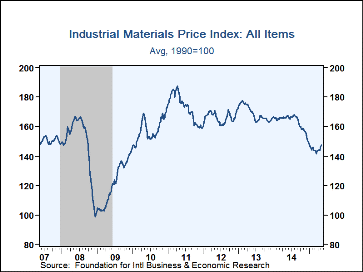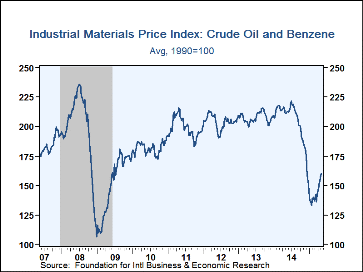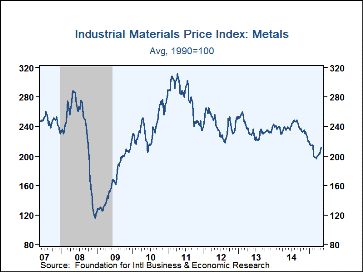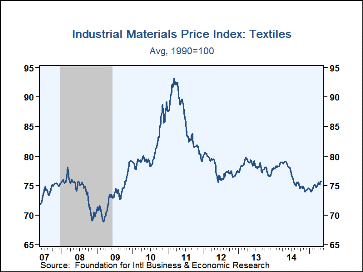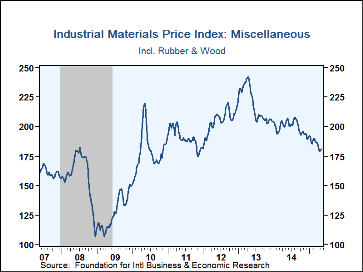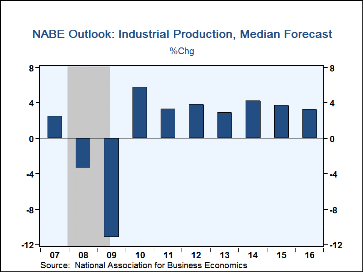 Global| May 11 2015
Global| May 11 2015FIBER: Industrial Commodity Prices Move Higher
by:Tom Moeller
|in:Economy in Brief
Summary
The industrial commodity price index from the Foundation for International Business and Economic Research (FIBER) improved 4.0% since the middle of March reflecting improvement amongst several industrial sectors. Prices in the crude [...]
The industrial commodity price index from the Foundation for International Business and Economic Research (FIBER) improved 4.0% since the middle of March reflecting improvement amongst several industrial sectors.
Prices in the crude oil & benzene grouping posted a 17.1% rise. The price for a barrel of WTI crude oil rallied to $59.15 as of Friday from the January low of $44.43, but was still off 41.5% y/y. The petro-chemical benzene also improved sharply versus the February lows, but remained down by just over one-third y/y. In the metals sector, prices also rallied since mid-March by 7.0%. Zinc prices led the rebound with a 17.1% increase (15.9% y/y) followed by a 12.3% rise (-4.6% y/y) in copper scrap prices since the end of January. Aluminum prices also moved 8.5% higher during the last eight weeks (10.0% y/y). Steel scrap prices continued to decline to the lowest level since the end of 2009 (-38.7% y/y). Prices in the textile sector also showed improvement with a modest 1.3% rise since the middle of March (-4.4% y/y). Cotton prices rose 7.5% but they're still down by roughly one-quarter y/y. Prices in the miscellaneous materials grouping remained depressed reaching the lowest level since December 2011. Framing lumber prices reached the lowest point since the middle of 2012 (-13.2% y/y) and structural panel prices declined 5.3% y/y. Natural rubber prices had relative strength moving 23.6% higher since mid-October, a low base. They remained down by one-half from the 2011 peak.
Continued support for commodity prices may be on the way. The current industrial output projection from the National Association for Business Economics calls for 3.7% growth in production in 2015 followed by a 3.2% rise next year. During the last ten years, there has been a 52% correlation between the three-month change in prices and the change in industrial output.
Commodity price data can be found in Haver's DAILY, WEEKLY, USECON and CMDTY databases.
| FIBER Industrial Materials Price Index (1990=100) | 05/08/15 | Y/Y % | 2014 | 2013 | 2012 |
|---|---|---|---|---|---|
| All Items | 147.07 | -11.2 | 163.5 | 169.0 | 166.3 |
| Textiles | 75.57 | -4.4 | 76.8 | 78.2 | 77.8 |
| Cotton (cents per pound) | 63.31 | -26.3 | 73.6 | 79.6 | 74.4 |
| Metals | 211.26 | -9.9 | 237.8 | 236.2 | 242.7 |
| Aluminum ($ per metric ton) | 1,870.00 | 8.9 | 1,864.9 | 1,846.7 | 2,016.6 |
| Copper Scrap (cents per pound) | 291.88 | -3.8 | 311.7 | 332.3 | 360.3 |
| Steel Scrap ($ per ton) | 230.00 | -38.7 | 358.3 | 345.8 | 366.5 |
| Crude Oil & Benzene | 159.37 | -24.7 | 205.2 | 207.7 | 204.0 |
| Crude Oil (WTI, $ per Barrel) | 59.15 | -41.5 | 93.5 | 97.9 | 94.2 |
| Miscellaneous | 180.68 | -10.6 | 199.6 | 218.3 | 205.2 |
| Framing Lumber ($ per 1000 board ft.) | 321 | -13.2 | 383 | 383 | 321 |
| Natural Rubber (cents per pound) | 136.69 | -2.8 | 140.2 | 190.0 | 211.8 |
Tom Moeller
AuthorMore in Author Profile »Prior to joining Haver Analytics in 2000, Mr. Moeller worked as the Economist at Chancellor Capital Management from 1985 to 1999. There, he developed comprehensive economic forecasts and interpreted economic data for equity and fixed income portfolio managers. Also at Chancellor, Mr. Moeller worked as an equity analyst and was responsible for researching and rating companies in the economically sensitive automobile and housing industries for investment in Chancellor’s equity portfolio. Prior to joining Chancellor, Mr. Moeller was an Economist at Citibank from 1979 to 1984. He also analyzed pricing behavior in the metals industry for the Council on Wage and Price Stability in Washington, D.C. In 1999, Mr. Moeller received the award for most accurate forecast from the Forecasters' Club of New York. From 1990 to 1992 he was President of the New York Association for Business Economists. Mr. Moeller earned an M.B.A. in Finance from Fordham University, where he graduated in 1987. He holds a Bachelor of Arts in Economics from George Washington University.


